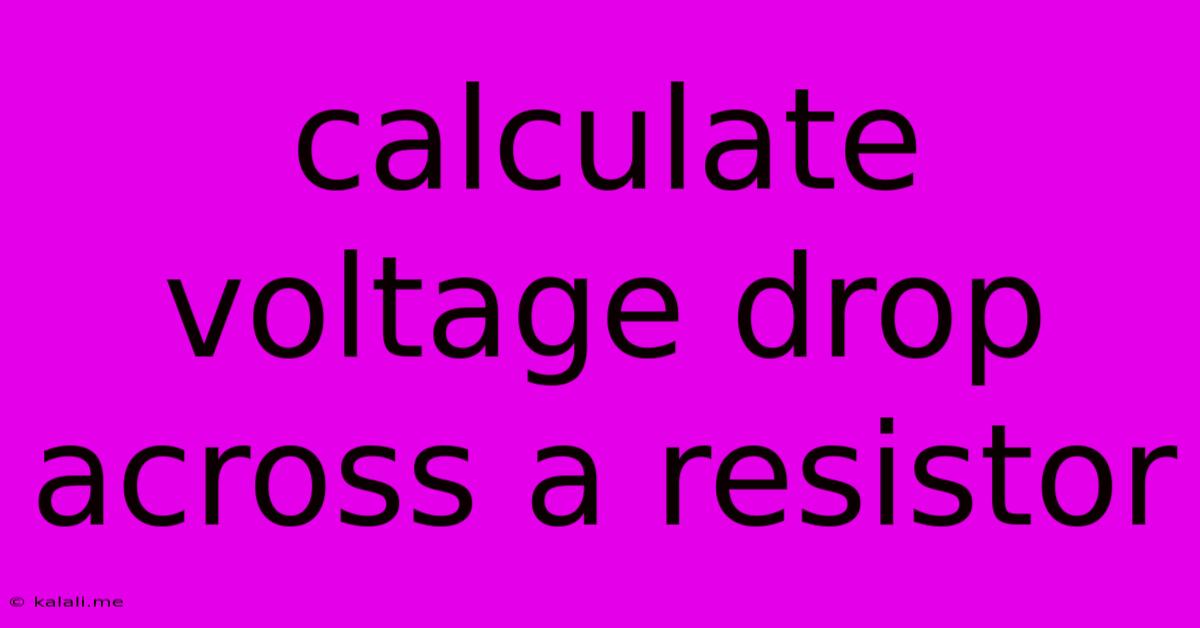Calculate Voltage Drop Across A Resistor
Kalali
May 30, 2025 · 3 min read

Table of Contents
Calculating Voltage Drop Across a Resistor: A Comprehensive Guide
Calculating the voltage drop across a resistor is a fundamental concept in electronics. Understanding this calculation is crucial for designing and troubleshooting circuits, ensuring components operate within their safe operating parameters, and predicting circuit behavior. This guide will walk you through the process, covering Ohm's Law and its applications, along with practical examples and troubleshooting tips. This article will equip you with the knowledge to confidently calculate voltage drops in various resistor circuits.
Understanding Ohm's Law: The Foundation of Voltage Drop Calculation
Ohm's Law forms the bedrock of understanding voltage drop. It states that the voltage (V) across a resistor is directly proportional to the current (I) flowing through it and its resistance (R). The formula is expressed as:
V = I x R
Where:
- V represents the voltage drop across the resistor in volts (V).
- I represents the current flowing through the resistor in amperes (A).
- R represents the resistance of the resistor in ohms (Ω).
This simple yet powerful equation allows us to calculate any one of these three variables if we know the other two.
Calculating Voltage Drop: Step-by-Step Guide
Let's break down the process of calculating voltage drop with a practical example:
Scenario: A 10Ω resistor is connected to a 12V power source. Calculate the voltage drop across the resistor.
Steps:
-
Identify the known values: We know the resistance (R = 10Ω) and the voltage of the power source (V = 12V). Since the resistor is the only component in a simple circuit like this, the voltage across the resistor will be equal to the power supply voltage. Therefore, the voltage drop across the resistor is 12V.
-
Apply Ohm's Law: To find the current first, you will need to use the formula I = V/R, which will give you the current flowing through the resistor: I = 12V / 10Ω = 1.2A
-
Calculate the voltage drop: The voltage drop across the resistor (V) is already calculated in step 1 in this simple circuit case. However, if there were more components or a more complex circuit, you would need to use Ohm's law again: V = I x R = 1.2A x 10Ω = 12V. This confirms our initial assumption for this simple circuit.
Series and Parallel Circuits: A Deeper Dive
The calculation becomes slightly more complex when dealing with series and parallel circuits.
Series Circuits: In a series circuit, the current is the same throughout the circuit. The total voltage drop across all resistors equals the source voltage. To calculate the voltage drop across a specific resistor, simply use Ohm's Law with the total current and the individual resistor's resistance.
Parallel Circuits: In a parallel circuit, the voltage across each resistor is the same and equal to the source voltage. The total current is divided among the parallel branches. You can calculate the current through each individual resistor using Ohm's Law and then calculate the voltage drop across that resistor using the formula V=IR. The voltage drop will be identical across each resistor in the parallel arrangement.
Troubleshooting Common Issues
When troubleshooting voltage drop calculations, consider these common issues:
- Incorrect resistor values: Double-check the resistance values using a multimeter.
- Measurement errors: Ensure accurate current and voltage measurements. Poor connections or faulty equipment can cause incorrect readings.
- Circuit complexity: For complex circuits, circuit simulation software can assist in accurate voltage drop calculations.
- Tolerance: Remember that resistors have a tolerance (usually 5% or 1%). The actual resistance might be slightly different from the nominal value. This should be accounted for in precision applications.
Conclusion
Calculating voltage drop across a resistor is a fundamental skill for any electronics enthusiast or engineer. By understanding Ohm's Law and applying it correctly to series and parallel circuits, you can accurately predict and troubleshoot voltage drops in various electronic systems. Remember to always double-check your calculations and measurements to ensure the accuracy and safety of your projects. This knowledge will enable you to build, maintain, and troubleshoot circuits with confidence.
Latest Posts
Latest Posts
-
Tree Dwelling Animal With Green Fur
May 31, 2025
-
Different Fairy Types In Fairly Odd Parents
May 31, 2025
-
How To Minus Front From Multiple Lines In Illustrator
May 31, 2025
-
How To Get Decals Off Car
May 31, 2025
-
How Do You Say What Is This In French
May 31, 2025
Related Post
Thank you for visiting our website which covers about Calculate Voltage Drop Across A Resistor . We hope the information provided has been useful to you. Feel free to contact us if you have any questions or need further assistance. See you next time and don't miss to bookmark.